Digital is Ephemeral21 July 2024 | 1:51 pm
I grew up in a rural area with frequent power outages. Because electricity wasn’t a given, especially in the winter, we always had kerosene lamps and flashlights on hand, and a woodstove with a range top and oven that we could cook with.
I had to learn the hard way that digital files aren’t always a given, either. Some of the things I wrote down about what my kids said and did when they were little, disappeared forever due to my using a 1990s word processing program with a now defunct file format. Thankfully at some point I switched to plain text and printouts; but those earlier files are lost for good.
The recent Crowdstrike outage briefly threw people back into the analog world with mom and pop businesses accepting only cash, and healthcare organizations resorting to keeping records on paper.
This is a good reminder that if you really, really want to depend on having something in the future, or allowing someone else to access it in the future (e.g. after a death in the family), it’s a good idea to keep a physical analog copy: paper books, printed photos, paper files and folders.
Digital documents and writings and images are subject to all kinds of hazards. Websites, articles, e-books, and apps disappear. Devices fail or are subject to planned obsolescence. File formats change. Links rot.
For digital documents you want to keep for a long time, I suggest the Three P’s:
- Plain text
- PDFs
And especially,
- Printouts
Copy and share – the link is here. Never miss a post from the Analog Office! Subscribe here to get blog posts via email.
Wondering how to manage your paper-based or hybrid paper-digital systems? Ask me a question.
20 July 2024 | 8:52 pm
Wondering how to find stuff in your paper notebooks, send reminders to Future You, and check out other solutions from the analog age? Visit the Analog Office “How To” Directory.
Reader Question 8: How do I handle a plethora of post-it notes?15 April 2024 | 11:46 am
“Hello! I don’t remember how I found Analog Office but I love it. It’s so comforting to read about processes and techniques that speak so loudly to me. My question is this:
“I take a lot of notes - to dos, things I’d like to remember or reference for later, etc. Some are in a small pocket sized notebook as they come to me (easy to carry, easy to write in, hard to organize, hard to review). Sometimes I put a post it note on the outside of the notebook for daily tasks but really it’s just an even quicker place to write notes down. I have more post it notes all over my desk. So many that I’m running out of room. The post it notes contain all kinds of things like a quote I’m trying to internalize in my work (drawing and art), questions for people, process notes regarding my art that I want to be reminded of daily as I work, goals for my art, things to try in my art, even a random financial note, and more. I love the quick access to them just being out but this is untenable. How do I organize this cacophony while still having constant visual reminders for the things that I’m practicing daily?”
What a great question! Post-it notes are so useful, and WOW can they multiply!
I love post-it notes! Here are some for special occasions:
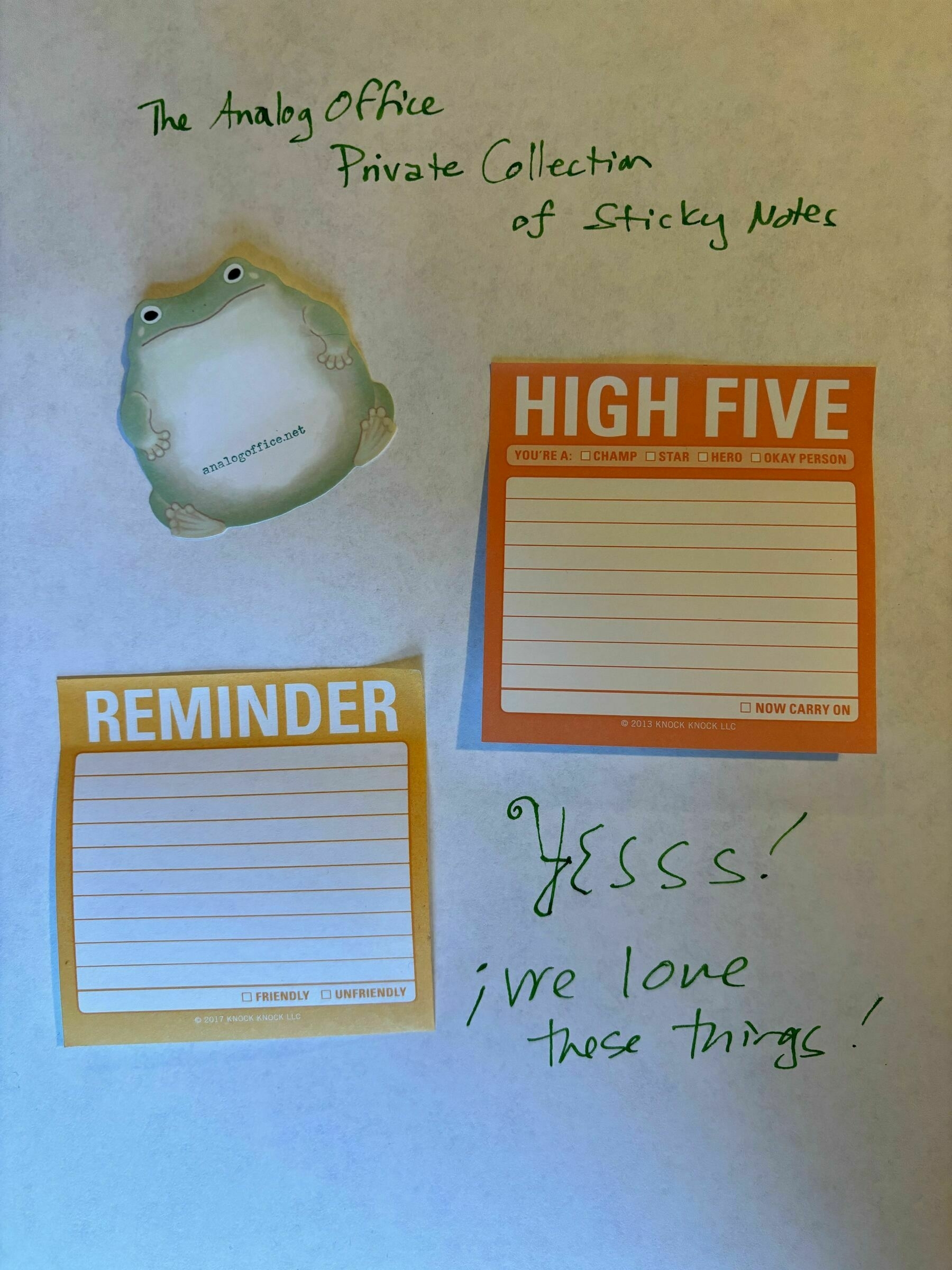
I even noodled around with keeping a post-it note Kanban board for myself*, but it just didn’t stick.
You mentioned that you were recording the following kinds of information on post-it notes:
- quotes for inspiration
- goals
- questions for people
- things to try out
- miscellaneous
You also said that at this point you have so many of them out that they are no longer easy to manage. What started out as a strategy to have quick, visual access turned into overwhelm.
This is not uncommon for those of us who make sense of our inner life through visual means, me very much included.
Keep Only the Fresh, the Live, the Relevant
So before you do anything else, really LOOK at those notes, every single one. Which ones have you become so habituated to, you no longer see them any more? Which ones have you already internalized and no longer need an external artifact for? Which ones are no longer relevant, or past the deadline, or no longer inspire you and feed your artwork?
Which still have a living spark for you, and which are just …old notes?
Your mind is a living system that needs to be fed. We might think of your notes like produce in the refrigerator, there to feed your imagination and help you with various workflows. But information, like produce, expires and gets stale. Information at some point is ready for the compost bin, er, I mean, the recycle bin. Last year’s reminders, right?
So your first step: Pick out the sticky notes that speak to you *today,* that are still fresh and relevant, that are still nourishing your mind, your imagination, and your spirit. Set those aside where you can easily find them again, because next you can organize them (see below for some suggestions).
The rest? The ones that no longer resonate for you? Stale. Faded. No spark in ‘em. Get rid of those.
If you can’t quite bear to get rid of all of them, put the ones that feel past their prime into a big envelope or a box, some kind of container, close it, put it somewhere out of your work space, and see what the space looks and feels like after you pull out the ones that are no longer fresh and relevant for you.
You only want fresh, relevant, currently inspiring notes in your work space.
Your work space is precious! It is where you spin things out of your mind in real things that can be shared with others!
Don’t dilute its power with stale notes.
And don’t organize before you declutter. Decluttering first, pruning down your stash before organizing, will save you a lot of time that you can then use for making art.
Next step: see how you feel with the ones that are left.
Is it too much, or just right?
Do you like having a mix of notes that kind of collide and bump off each other, or does it still feel like “too much”?
If it still feels like too much, then you might want to try organizing the notes that are left into categories.
Keep Like With Like
Why organize these notes? Because there is a balance between an inspiring mix of things that help you create, and an overwhelming mix that stalls your creative process. The balance is different for everyone, but if – after getting rid of the stale notes – your space still seems visually intrusive rather than visually inspiring, it’s time to play with some ways to bring in order.
Because organizing is so highly personal – we are, after all, considering how to arrange an extension of your own mind – I’ve got several suggestions below for keeping your post-it notes accessible and your workspace as clear as you want it to be.
Sort the notes into categories that make sense for you; the ones you will reach for when you want inspiration, or need to check reminders, or however you divide these various notes in your mind.
I’ve kept it simple in the illustrations below, with “goals,” “reminders,” and “quotes,” but use the words that come to mind for your context. Maybe you prefer categorizing words like “inspiration,” “deadlines,” “questions.” Or something else entirely.
In any case, you might try the following.
You could put notes into folders dedicated to a single category:
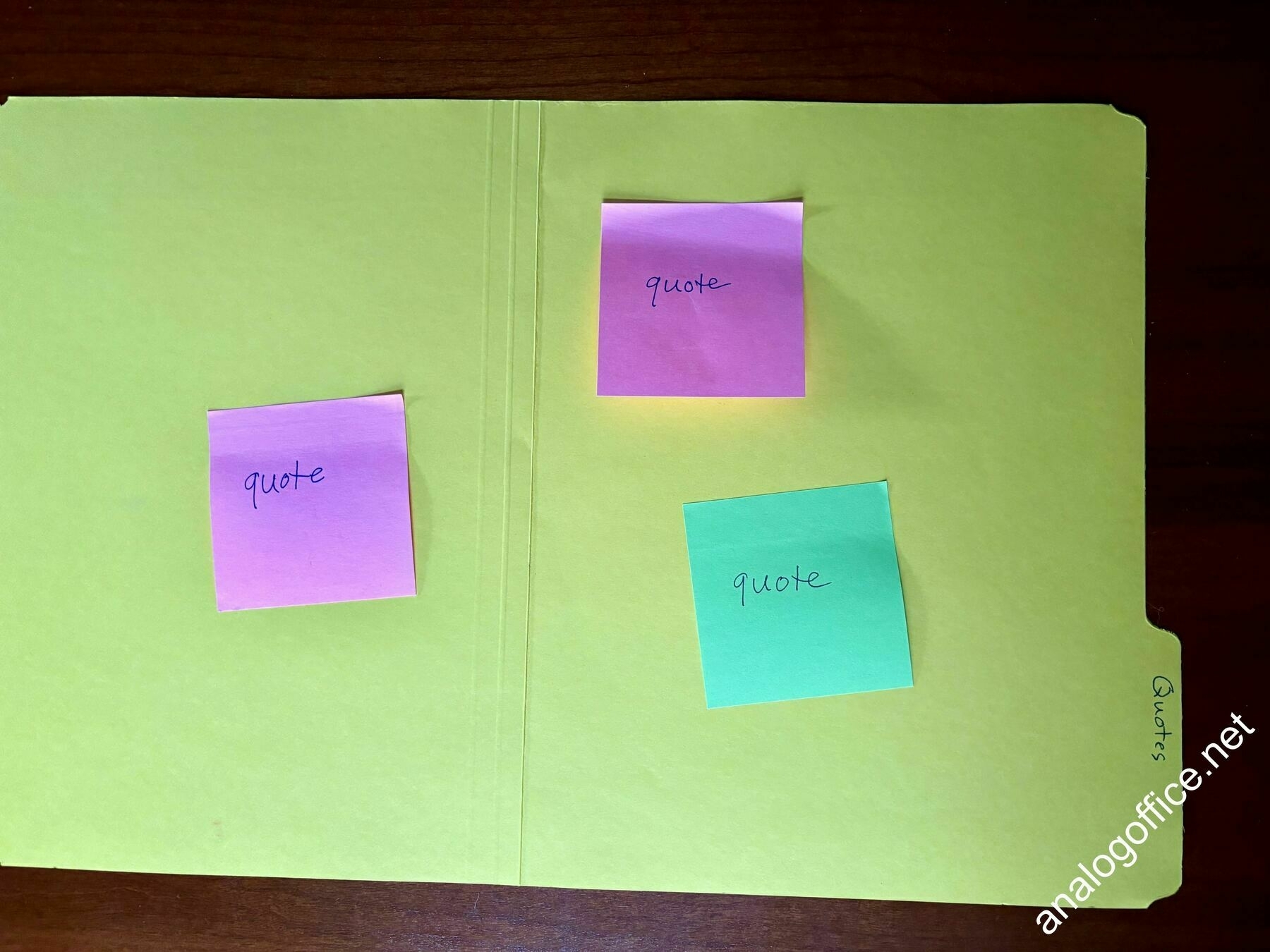
You could put notes into a folder with a couple of categories, marked by dividing lines:
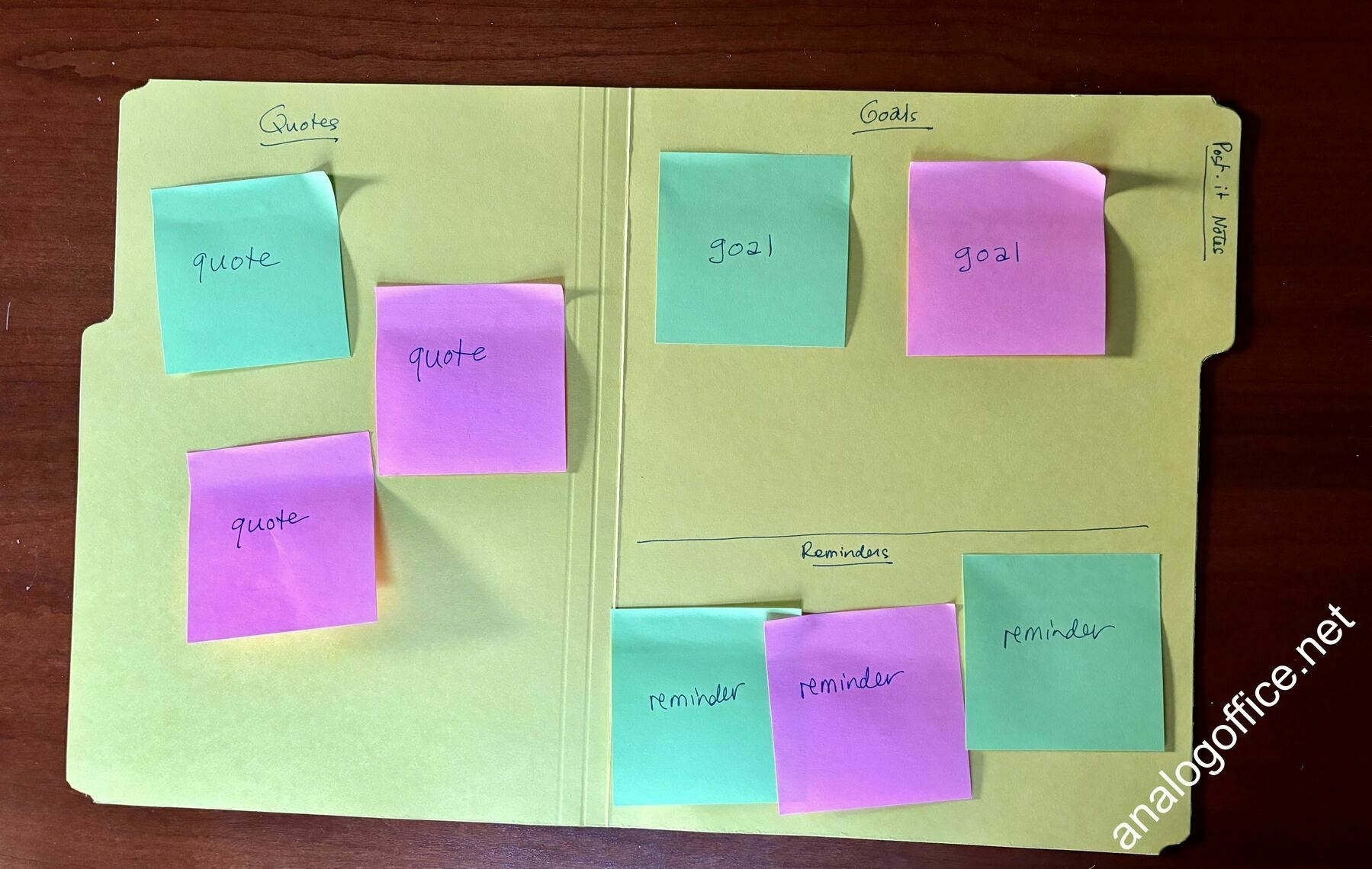
If you have a lot of notes, or don’t want to mess with multiple folders, you could put notes on paper in a three ring binder, and use binder dividers or tabs for various categories:
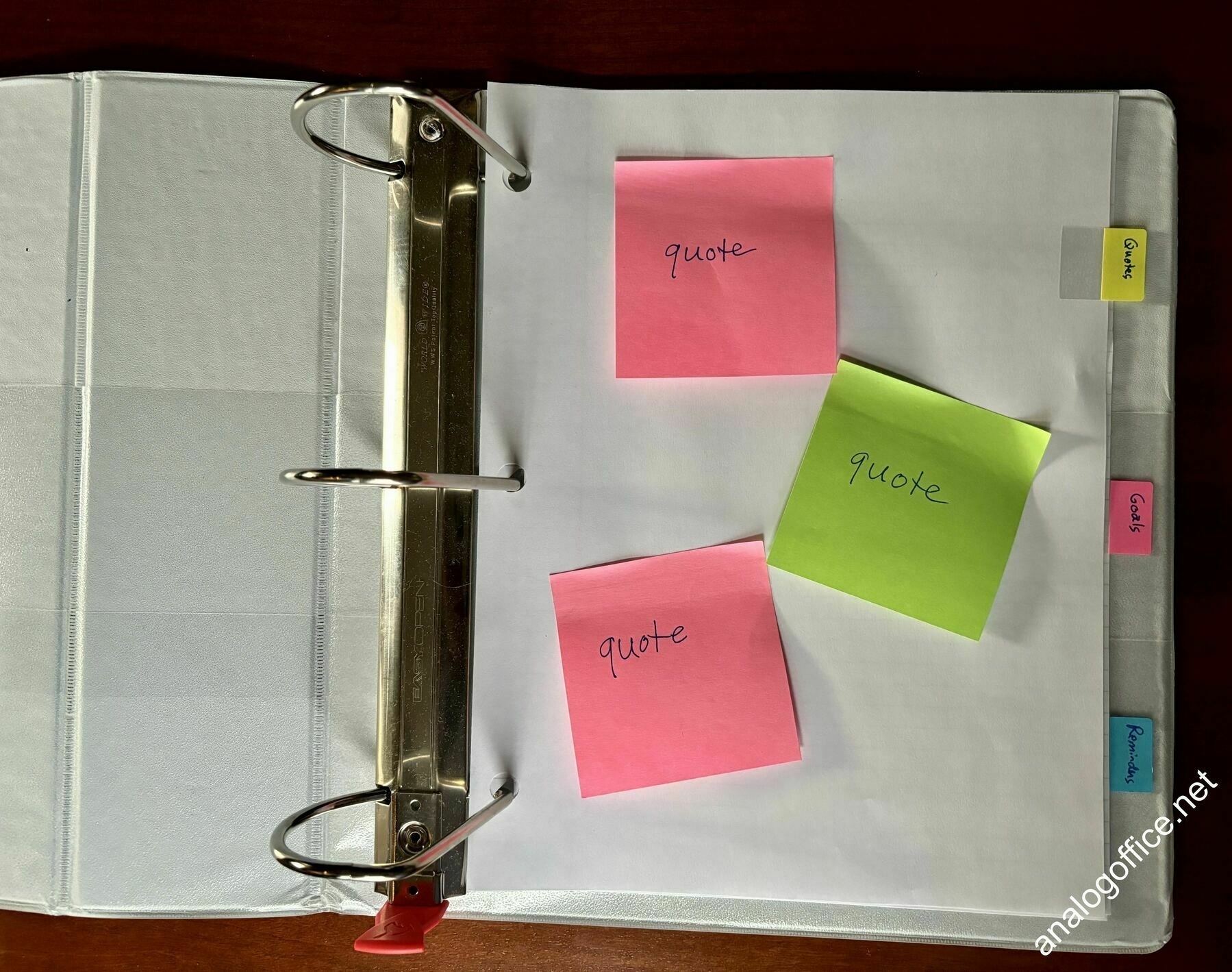
And – if you really want to keep some visual and visible in your workspace, you could put notes in picture frames to contain them:
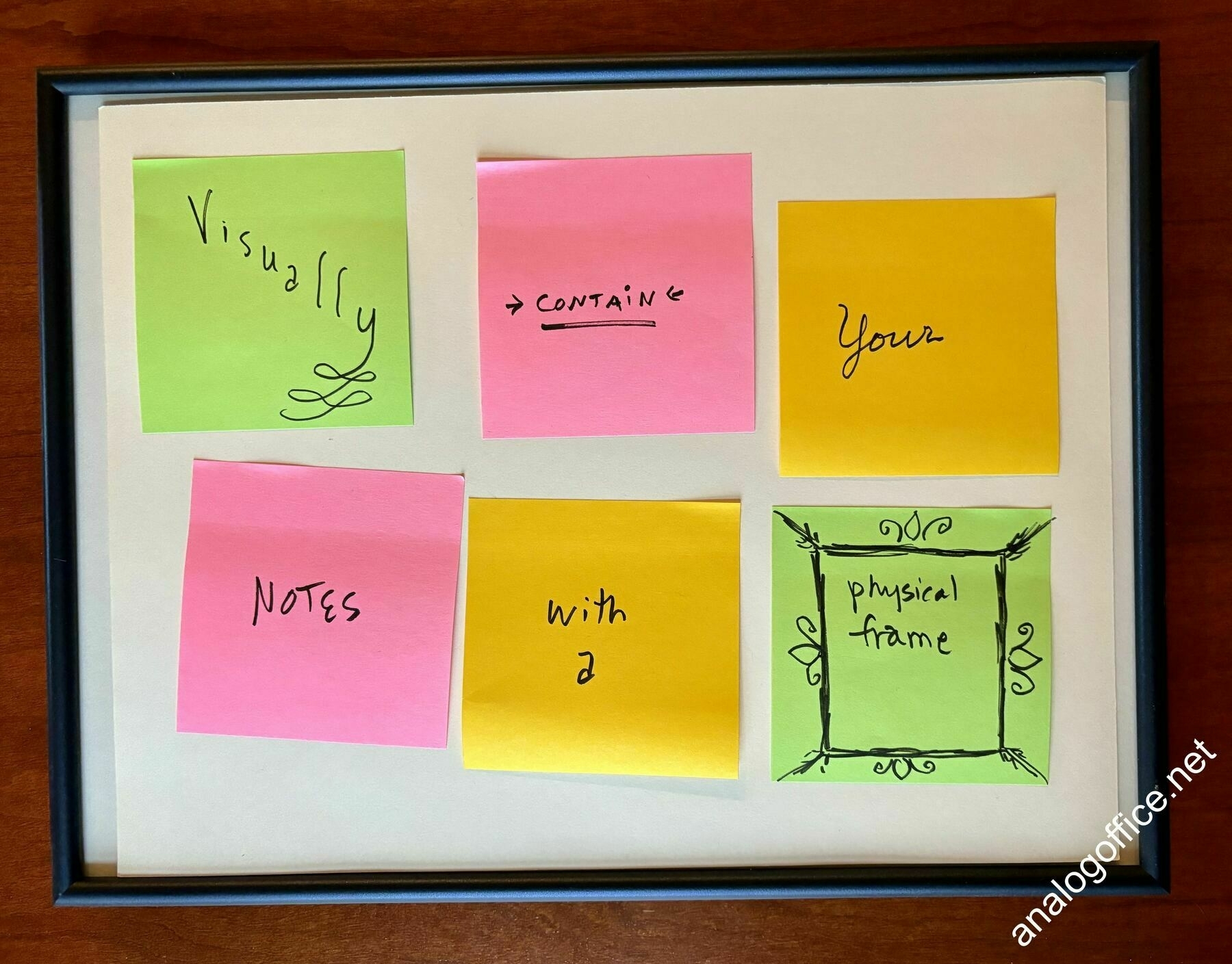
I hope this helps your creativity to flourish! Thank you for writing in.
References
Kanban Method (no date). Available at: https://www.post-it.com/3M/en_US/post-it/ideas/articles/kanban-method/ (Accessed: 11 April 2024).
Paul, A.M. (2021) The extended mind: the power of thinking outside the brain. Boston: Houghton Mifflin Harcourt.
Notes
* So, about that 3M corporation link about doing a kanban board for teams with a post-it note? It’s a great visual example of what a post-it note kanban board can look like, but then they propose that you add an app, and – look, somebody is going to LOSE one of those important work project post-it notes. They just will! It’s that kind of world, that we live in! Any work-related collaborative projects I needed to do had so many files and attachments and meta-info, they were beyond the capacity of post-it notes. I happily used Trello for many years to manage those. But for personal tasks, I think a little kanban post-it board is do-able.
Copy and share – the link is here. Never miss a post from the Analog Office! Subscribe here to get blog posts via email.